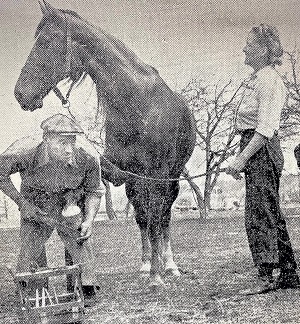FARRIER'S ART CHERISHED BY SEYMOUR CRAFTSMAN
 Farrier's Art Cherished by Seymour Craftsman
Farrier's Art Cherished by Seymour Craftsman
(Appleton Post Crescent October 20, 1963)
This summer Jim Earley donated a forge, anvil and a variety of blacksmith tools to the museum in memory of Jack Kissinger. Jack came to Seymour in 1917 primarily because of the horse races at the fairgrounds and the need for a farrier. He passed away in 1978. This newspaper interview with him provides some little known facts about the life of a farrier.
Jack Kissinger is a craftsman in a business that is fading since the automobile became popular. He is a farrier, or what most of us call a horse shoer. And he has been in the business for 56 years.
Jack is wiry and tough and he has to be to handle ornery horses who don’t want people bothering with their feet and legs. But he says working with horses takes som
ething different than just muscle.
“Some people say I hypnotize horses,” he says. But it really isn’t that. A horse can tell if a person has confidence. A horse needs to rely on a man. That’s what does it.
Good Training
Jack started his trade when he was 17 and freshly arrived in Wisconsin from his native South Dakota. Apprenticed to Henry C, Volkman of Milwaukee, he spent four years working for his journeyman degree.
There were seven forges in the blacksmith shop and a wide variety of men Jack recalls. He learned about shoeing hackneys from an Englishman and hunters from an Irishman. Then he spent four more years working for his master degree.
In those days horse shoers belonged to the National Horse Shoers Association and Jack was a Traders Council delegate. When he started his apprenticeship he was paid $7.00 a week and worked up to $12.00. In 1917 he moved to Seymour, in part because of the race track.
Best Experience
Shoeing race horses is the best experience for a horse shoer, Jack believes. The slightest difference in a shoe can make a great deal of difference in a racer’s performance. Problems in such shoeing range all the way from making the almost shell-like four ounce shoes to help the pacer develop rhythm to special shapes and weights to correct forging, cross-firing or simple stumbling.
When Jack started at Seymour he recalls there were other shops in town because automobiles were scarce and horses were plentiful.
Jack had two men working for him and there was plenty for all to do. He says the horse population in Wisconsin has about doubled in the last five years. There are more race horses, but the big increase has come through the renewed interest in saddle horses.
The only trouble with shoeing saddle horses Jack says that their owners don’t pay much attention to the shoe as long as everything is going right. But Jack keeps records of every horse, measurements of the length of the hoof and the shape of the shoe. He has become adept at making light shoes for the Arabian’s floating trot, the heavier front shoes for the higher action required of the American Saddlebred and even an elaborate shoe concocted of iron and leather to build out a Tennessee Walker’s hoof as much as six inches.
Slow Down
Because he is 73 he has to take things a little easier. Jack has had to curtail some of his work and only goes to a few stables on regular trips. But he is kept busy in his own shop in Seymour, filling orders for shoes from all over the country.
People send him patterns for the shoes they want along with measurements and descriptions of whatever the horse is doing wrong. But he also makes shoes on the spot because he carries his complete equipment including a forge in the back of his truck.
Shoeing has changed Jack concedes. He used to be able to shoe 10 horses a day, but the young men going into the business today usually stop at about four. Jack is critical of their training. In many of the schools he complains that they spend years studying hooves and nailing shoes to dead horses, but may not even see a live horse until graduation.
Too Hurried
They are in too much of a hurry he says and don’t spend enough time to be sure the job is done right. If he has been a successful horse shoer, Jack says it is because he is never perfectly satisfied with his work. Í always think that next time I will do it a little different and a little better.
Blame Man
In the shop where he was trained, Jack recalls that if a shoer had trouble with a horse, the man and not the horse was blamed. One of the first rules was to never hit a horse with a shoer’s tool and Jack remembers one man given his time for striking an unruly horse with his rasp.
Each horse is different, Jack says. Some respond with a sharp voice and others to a gentler approach. And some he concedes have to be whacked with a piece of rubber hose.
When he came from South Dakota, “I could ride anything with hair,” and Jack thinks getting along with horses is essential to the trade.